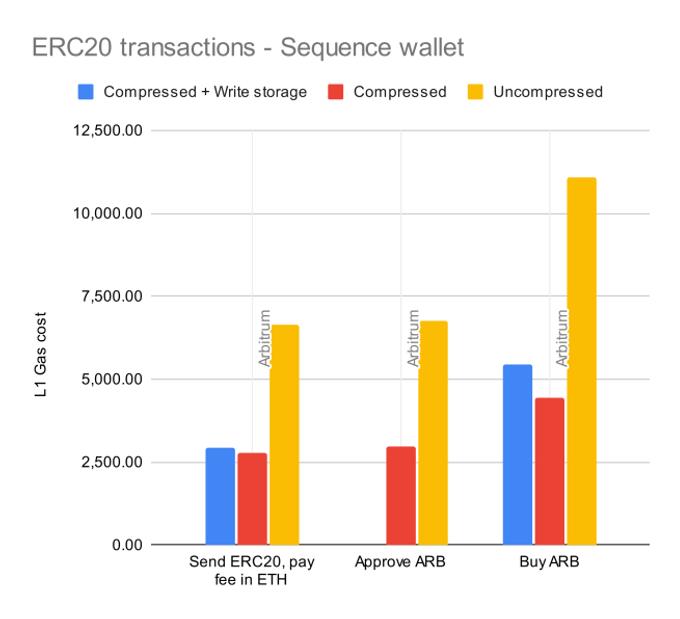Compressing calldata - L2 fees cut by 50%
February 14 2024

TL;DR:
We have reduced gas costs on L2s by ~50% for all Sequence transactions. We have achieved this by compressing calldata by ~5x.
These savings automatically impact all wallets without the users having to update them. The compression is now live on Arbitrum, Arbitrum Nova, Optimism, and Base.
In the EVM chain ecosystem, there are primarily two kinds of networks: L1s and L2s. L1s are standalone chains that don't need to primarily hook to another chain to work. In this category, we find chains like Ethereum.
The other category is L2s. These chains use a combination of techniques to leverage the properties of an underlying L1, allowing L2 chains to relax their operational limits and thus reach higher throughput.
We will focus specifically on one kind of L2, the rollup. Here, we can find networks like Arbitrum, Optimism, Polygon zkEvm, base and zkSync.
Rollups work by an amalgamation of two properties:
- All "input data" is published, allowing anyone to read it.
- Anyone can "raise an alarm" if they see that the blockchain does something it shouldn't do.
This is (again) a big simplification, but the important thing is that a rollup operates with a different set of trust assumptions.
In a rollup, anyone can read the data, and anyone can verify it (so far, like an L1), but the difference is that if one entity sees something wrong, it can alert all other entities. This means that the network can be safe as long as there is one honest participant in the whole network.
How Does This Relate to Calldata?
In an L1, a majority of the nodes need to be able to sync and validate the chain. However, in a rollup, as long as one honest entity is able to validate, then the chain is considered safe. This allows the rollup to increase the "requirements" for running a node, without compromising on decentralization.
But there is still a "hard" requirement:
All "input data" is published, and anyone can read it.
This means that, even if the rollup can afford to make running a node expensive, it still needs to deal with publishing all this data. Rollups publish this data to a data availability layer (like an L1 or Celestia), leveraging the properties of the L1 to ensure that the data is available for everyone.
This leads to an interesting property: both Rollups and L1s have gas, but they price certain actions differently.
L1 Networks tend to charge more for computation and "long-term storage," since every node must replicate these values for the network to be secure.
L2 Rollups, on the other hand, charge a lot less for computation and storage, but they do need to charge more for input data (calldata) as this needs to be published into the L1.
Building a cross chain wallet
For most applications, this distinction is not a problem. If you are targeting L1s, you can use "stateless" patterns that move most data to calldata and only use the minimum required storage. If you are targeting a rollup, you can flip it around and move most data to storage, minimizing calldata.
But when building a cross-chain wallet, one of the desired properties is that the wallet must have the same address on different networks. This reduces the risk of the user sending funds to an "invalid address" on the wrong chain.
The problem is that, to get the same address on different chains, the initial code of the wallet contracts must be identical. There are ways around it (like starting all contracts with the same code and then doing chain-specific updates), but having the same contract implementation on all networks helps in different ways too, like simplifying the wallet architecture.
So, a wallet must choose: does it optimize for L1s or L2s? In Sequence, we optimized our wallets for L1s, meaning that almost all data is passed as calldata. This makes our wallet the cheapest AA wallet on L1s, but it has the side effect of increasing costs on L2s.
However, by implementing the following, we are releasing an update to our relayer, bringing down gas costs for L2s too.
Compressing data
One technique that allows us to achieve the best of both worlds is data compression. We can add an optional contract layer that decompresses the data, only to be later passed to the wallet contracts.
Let's go over a simple example of sending a transaction bundle, which does two things:
- It sends some ERC20 tokens.
- It sends some ETH payment to the relayer to cover the gas fee.
If we take a look at the decompressed calldata, we are going to see something like this:
0x7a9a16280000000000000000000000000000000000000000000000000000000000000060000000000000000000000000000000000000000000000000000000000000000d00000000000000000000000000000000000000000000000000000000000002e0000000000000000000000000000000000000000000000000000000000000000200000000000000000000000000000000000000000000000000000000000000400000000000000000000000000000000000000000000000000000000000000180000000000000000000000000000000000000000000000000000000000000000000000000000000000000000000000000000000000000000000000000000000000000000000000000000000000000000000000000000000000000000000013aa7000000000000000000000000912ce59144191c1204e64559fe8253a0e49e6548000000000000000000000000000000000000000000000000000000000000000000000000000000000000000000000000000000000000000000000000000000c00000000000000000000000000000000000000000000000000000000000000044a9059cbb000000000000000000000000b70d2e30b2d2f8af8b657f5da5b305ec533f6dc200000000000000000000000000000000000000000000000002004d22d09c8000000000000000000000000000000000000000000000000000000000000000000000000000000000000000000000000000000000000000000000000000000000000000000000000000000000000000000000000000000000000000000100000000000000000000000000000000000000000000000000000000000f4240000000000000000000000000c3453b0c9ba0161a3c535627b15fcf8b9407efb9000000000000000000000000000000000000000000000000000118600d8d460000000000000000000000000000000000000000000000000000000000000000c00000000000000000000000000000000000000000000000000000000000000000000000000000000000000000000000000000000000000000000000000000015d000500000064034ab447f5ad4706997a759d614d83eebc28bb69991a7a8ac49acc5dd3d5bf0cd804000132039267d5e93c128fa0b8c95b832a9300ace37988c8548be41bbcf94073763644af0400010d039b30b47e658be219a5a295f3c4d110b7eda2922d910548699750f69e14b33a46040000e803e6a553536055f33ae3a9fbdc4d51c3802a191a78ad0460cfd5030f5ca5be0e31040000c300027ea42f979fbe5f71e8389288f2d5d861afaf7252c17e81ae423ea1b7919917aa17ff111b8a492ff3b79339bd4e13ba36e11c0f280b74bccf6c579b7fdab5802c1c020400007b0203761f5e29944d79d76656323f106cf2efbf5f09e9000062010001000000000001bf190d900ea21f0801a45a2325a95ebb5de41142d9c7a160803a2e0bb13e8d8d1f8d7c54c59d452c23ddfab8d359c5f252b248e531dd1bb4230d1545a2161fe11c02010190d62a32d1cc65aa3e80b567c8c0d3ca0f411e6103000000
This calldata contains:
- The nonce of the transaction (for replay protection).
- The list of transactions that we want to do (send ARB, send ETH).
- The signature for the smart contract wallet.
Let's disassemble it a bit further so we can understand each part:
In the disassembled image, we can better appreciate the different parts of the transaction, and we can spot different inefficiencies:
Static values
There are quite a few values that are always the same for all Sequence transactions. These include:
- The
0x7a9a1628execute function signature. - The "start of transactions."
- The structure of the transaction.
The structure of the transaction is the most important one, as lots of values (start of transaction, start of calldata, etc.) exist only to define this transaction structure. If we are going to build a compression schema that is only meant for Sequence transactions, then we can skip all this data.
Padded values
In multiple cases, we can see that we want to provide very little information (a boolean, a 2-digit number, etc.) but we still need to add a lot of zeros to their left.
This is because ABI encoding uses 32-byte words, so all values must be passed as 32-byte words. This leads to lots of wasted space in "0s"; we don't need 32 bytes to store "the number of transactions", we can just use 1 byte for that.
Bitmaps
We can go even further by using bitmaps to pass some data, for example, "revert on error" and "uses delegatecall" can only be true or false; we only need a single bit to express this information.
We can have a single "flags bitmap" per transaction. We can use the bitmap to express the following:
- Does it use delegatecall?
- Does it revert on error?
- Does it have a capped gas limit?
- Does it send a value?
- Does it have calldata?
This allows us to compress transactions significantly since when a transaction does not use a value, we can just not pass it; we don't even need to pass a zero.
A Few More Tricks
Function Selector
We can go a bit further by exploiting common patterns that appear in most transactions. For example:
0xa9059cbb is the function selector for sending ERC20 tokens. Sending ERC20 tokens is one of the most common actions on Ethereum, and it goes beyond just this example.
If we take the top 255 most used function signatures, we will see that they represent 90% of all Ethereum transactions. This means that for 90% of Ethereum transactions, we can represent their function selector with a single byte.
Scientific Notation
We can use scientific notation to represent "common numbers" in a more compact way. For example, most users always send amounts that are round numbers based on 10.
Let's say that you want to send 301.22 ARB. This might seem like a small number, but you must remember that ERC20 tokens tend to have 18 decimals.
When we include all the decimals, and we convert 301.22 ARB to binary, we get this:
0001 0000 0101 0100 0100 0100 0110 1010 00010001 0110 1011 0010 1010 0000 0000 0000 0000
We need 18 bytes to represent this small number! However, we can use scientific notation to represent it in a different way, using an exponent and a mantissa.
1016×30122=301220000000000000000
This alternative in binary can be represented as:
([constant 1010] ^ 01 0010) * 00 0111 0101 1010 1010
This lets us represent the exact same number, but using only 3 bytes. "Rounder" numbers can even get down to 2 bytes.
First Compression Pass
Let's see how much of the calldata we can trim away if we remove this redundant information:
The grayed-out text represents data that, after compression, we no longer need to include.
Of course, if we tried to compress the transaction down to only this data, we would be stuck with only being able to compress this very specific transaction. So, in real life, we need to add 1 extra byte before each colored part.
This strategy alone already gives us significant calldata savings, and so far, we are only compressing and packing; we are still relying 100% on calldata to pass around the information.
Obligatory Disclaimer
This post is not meant to be a critique of Solidity ABI encoding. ABI encoding has all this overhead because it must be cheap to read and cheap to write. Our compressed data will be unpacked in a single pass, and it is a lot harder to "write".
In other words, all this overhead exists because Solidity ABI can't specialize in a single task; it must work for all sorts of contract communication. In our case, we can specialize, and that's okay.
Second Compression Pass
So far, we've only tried to compress the data with the tools at our disposal (another calldata and code), but in rollups, it makes sense to use another tool for the job: contract storage.
In our example transaction, we have a few contract addresses, each one of them uses 20 bytes of calldata:
0x912ce59144191c1204e64559fe8253a0e49e6548ARB token address0xb70d2e30b2d2f8af8b657f5da5b305ec533f6dc2ARB recipient0xc3453b0c9ba0161a3c535627b15fcf8b9407efb9Relayer address
The very first time we use these addresses, we must pass them as calldata, but we can take the opportunity to also store them in a sort of "directory". The next time any of these addresses need to be used, we can reference them by a "directory index" of only 3 bytes.
This lets us go from 60 bytes for 3 addresses to only 9 bytes total.
Sequence Signature
I have avoided talking about the Sequence signature (the purple part) so far. The reason is that our signatures are already tightly packed, so we can't pack them much further.
However, our signatures are always proofs of a Merkle tree, so they do contain a lot of data that repeats from transaction to transaction.
Let's analyze the example signature:
It is important to notice that most Sequence transactions have two inner ECDSA signatures, one wrapped inside an EIP1271 signature. So, this example signature contains:
- A Merkle proof.
- An ECDSA signature.
- An ECDSA signature wrapped inside an EIP1271, plus its own proof.
And the representation is still quite compact, but we can do better for L2s.
Branch Hashes
This signature is part of a tree, meaning the signature itself is a Merkle proof. When building the signature, we don't need to pass the contents of the whole tree, but we do need to pass the hashes of every unused branch.
This signature has a lot of branches! The reason is that this Sequence multisig wallet has >100 signers. This is not normal for Sequence, but it showcases how our transactions remain cheap even under heavy synthetic scenarios.
However, a key point is: branch hashes remain static across transactions (for a time, until the user rotates some keys). This means we can store them and reference them using indexes, just as we do with addresses.
Each branch hash takes 32 bytes. We can reduce them to only 3 bytes each.
ECDSA Signature
Sadly, EOA signatures can't be compressed (unless signature aggregation is used). For now, we will leave this data as-is.
EIP1271 Signature
In the case of EIP1271, one low-hanging fruit is to save the signer's wallet address to storage (like any other address), which gives us 17 bytes of savings.
Additionally, in this case, the EIP1271 signature is another Sequence signature. This means we can repeat the whole process again, compressing the inner EIP1271 signature too.
Final Trimmed Transaction
As I said before, this is only an approximation of the real compressed transaction; there is a bit more data that needs to be included.
However, we can appreciate how the whole transaction can be made more compact, not only the transaction data itself but also the signature.
Back to the Real World
We have implemented the above-mentioned compression schema for our Sequence wallets. It works using a custom-made state machine, implemented in Huff. This allows us to decompress the transactions in the most efficient way possible while retaining the flexibility of compressing any sort of transaction.
The above-mentioned transaction (a copy of it) can be compressed down to this calldata:
The original data goes down from 1124 bytes to 220 bytes, a compression ratio of 5.109. All this considering that the original data has 132 bytes of uncompressible information (the ECDSA signatures).
Show Me the Numbers
We tested a variety of compressed transactions on Arbitrum. It has to be mentioned that the same compression gains can be applied to Optimism-based networks. Arbitrum Nova also partially benefits from compression, but only from packing.
Sending ETH
This is the simplest scenario there is: sending ETH without doing anything more. In the example we perform this test twice.
In the first transaction, we need to write a lot of storage data (branch hashes, wallet address, etc.), so the compressed + write storage value is a lot higher. In the 2nd transaction, most of the wallet-specific data is already written, so we only need to store the new recipient.
The savings from packing the data are enough to offset the cost of storing all "long-term" words and addresses using contract storage (this can be seen in the first transaction, being cheaper even when writing storage).
The first transaction gives us a 15% gas cost reduction even when totally cold, subsequent transactions get a gas reduction of 47%.
The second transaction only needs to write to storage a single new recipient, so the difference between the two compression runs is a lot lower.
Send ETH uncompressed (1st): 0xa0efbb458309f1ccc14035a53e20c36155d722b1c5d991bfa7c43a21174ec468
Send ETH compressed + write storage (1st):
0x9a34d5787b0dd6fba248ebeb407d51526445b496f45f2b4f6ff1d56875f04f7c
Send ETH compressed (1st):
0x6197b0770cdb3efcdb252bf3932ff9964e3467906a7ac1de6361e2d9fe1bb84e
Send ETH uncompressed (2nd):
0x7b519df3f10a0e0ae507d6d18d775f1ed80e65c76df06e5632f402903cd9afb8
Send ETH compressed + write storage (2nd):
0x1680bae9b790bb54d522ebc033da92cb5261b73c27058767c55011957083ea41
Send ETH compressed + write storage (2nd):
0x1ccc93227065df0b9d6acc64504280ad7e55b5823b90111a0b6477c881291de4
Send ERC20 Tokens
This is the example that we have seen so far. Testing both compressed, compressed (while writing storage), and uncompressed, we can see the following gas usage:
Transfering an ERC20 can be done for 50.60% less gas when we need to write the storage for the first time, and 54.24% when we have all the data in storage.
Approving is also a lot cheaper since we can represent the typical maximum approve value:
0xffffffffffffffffffffffffffffffffffffffffffffffffffffffffffffffff
Using only 2 bytes.
This gives us 52% savings when approving ERC20 transfers.
And since our compression algorithm is general purpose, we can compress more complex operations, like Uniswap swaps, giving us up to 56% savings on them.
Send ERC20 uncompressed:
0x0559ea8161e9cfed3298091d1f7626fe551bd40a38d2ff65d2340a52203e582a
Send ERC20 compressed + write storage:
0xbbf1d0250c37155f2da1d72cc01ff68fb5ccd4b4834a4accf53caf9374e64e3b
Send ERC20 compressed:
0x07e3b4de0b2cd3c8c531e90f32afc7a5dc3691b399ae4ab33d833b3e10741d05
Approve ERC20 uncompressed:
0x03c5f3d5c5a556439215c751a0d84b838266e9ec2481f862a912943e1bc309d6
Aprove ERC20 compressed:
0x7186dcf623d6bf5436691d28c649215900c4c71c2061863b0388786e07299428
Other Chains
Most EVM L1s tend to copy the gas cost model from Ethereum, but different L2s implement different models, affecting the compression performance.
Optimism
The Optimism-based rollups benefit similarly from the compression savings. This makes sense as both Arbitrum and Optimism publish their data in a similar fashion.
L1s - Ethereum, Polygon
Non-storage-based calldata saving schemas can be applied to L1s, but calldata is really cheap on them, so the "budget" left for decompression is too low. In short terms, with the current pricing schema of L1s, compression is not a viable strategy.
In the future, this may change if any of the ongoing proposals for increasing calldata cost on L1 take hold.
Next Steps
We are going to be rolling out our compression system on our L2 relayers. This will reduce most Sequence transactions to half of their original cost.
EIP-4844 is just around the corner. These gas optimizations, alongside the reduction of the calldata cost from using blobs, should compound together to make AA wallets an attractive option for L2s.
If you want to integrate this compression system into your contracts, you can find the libraries for encoding/decoding calldata, alongside a more detailed explanation of the inner workings of the system, all in this repository:
https://github.com/0xsequence/czip
We hope this post can inspire other smart contract wallets to implement these techniques. Making smart contract wallets more efficient will help alleviate the load of L2s while making Account Abstraction more attractive.
Sequence makes building onchain simple. Developers and teams can launch, grow, and monetize apps with unified wallets, 1-click cross-chain transactions, and real-time data, all in a modular and secure stack. No more stitching together fragmented tools or battling poor user flows. Sequence is production-ready infrastructure that helps teams ship faster, onboard more users, and scale confidently. From chains and stablecoins to DeFi and gaming, Sequence powers developers and applications across the EVM ecosystem with billions in transaction volume and millions of users. Trusted by leaders in blockchain, Sequence powers today’s onchain apps and delivers future-proof infrastructure for tomorrow’s breakthroughs. Learn more at sequence.xyz.
Written by

Agustin Aguilar
Director of Blockchain Research at SequenceRelated Posts
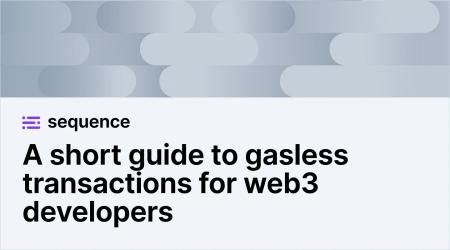
A short guide that explains exactly what gasless transactions are, and why they matter for your web3 experience.
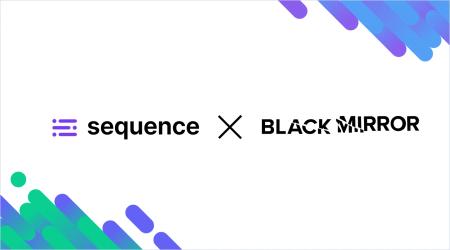
In partnership with KOR Protocol, Sequence and Msquared, Black Mirror's franchise has launched the $MIRROR token and a new web3 experience!
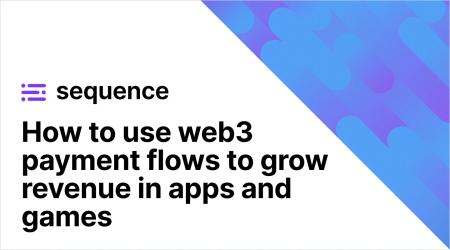
Web3 payment flows allow any app to embed onchain purchases and interactions in a way that feels natural for users. Learn more about them!
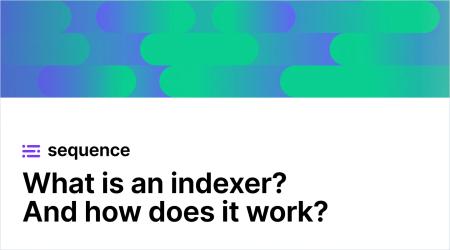
As more applications and protocols move onchain, indexers redefine how dev teams access, organize, and use blockchain data. Learn how!






